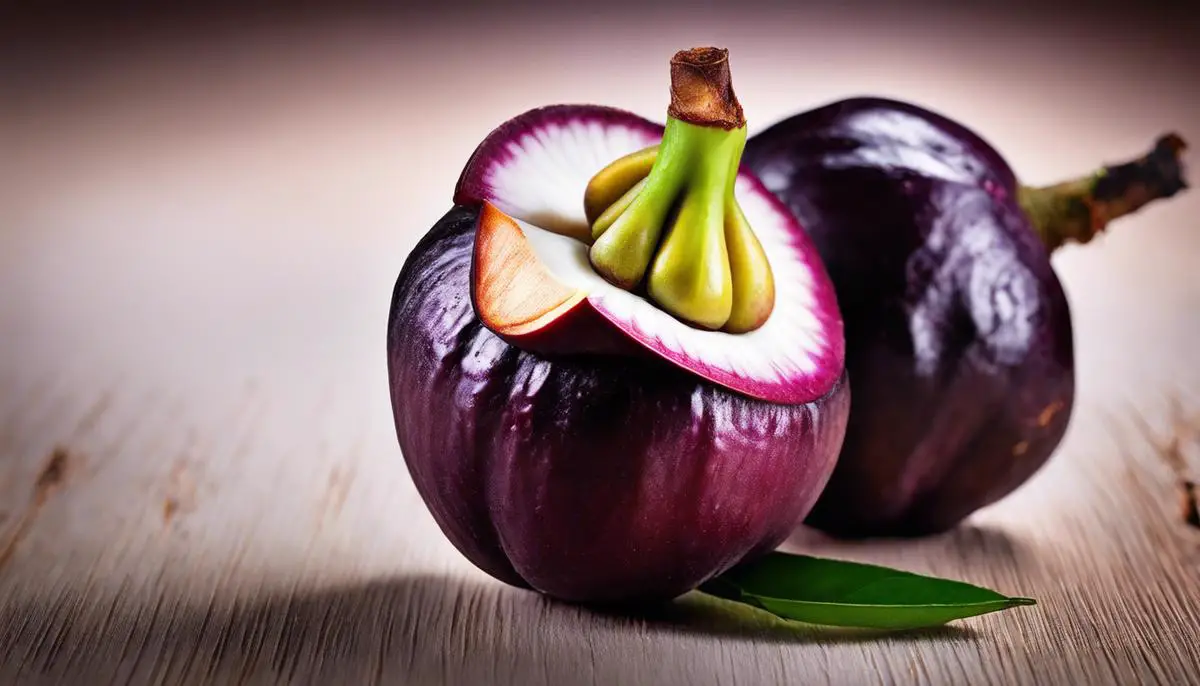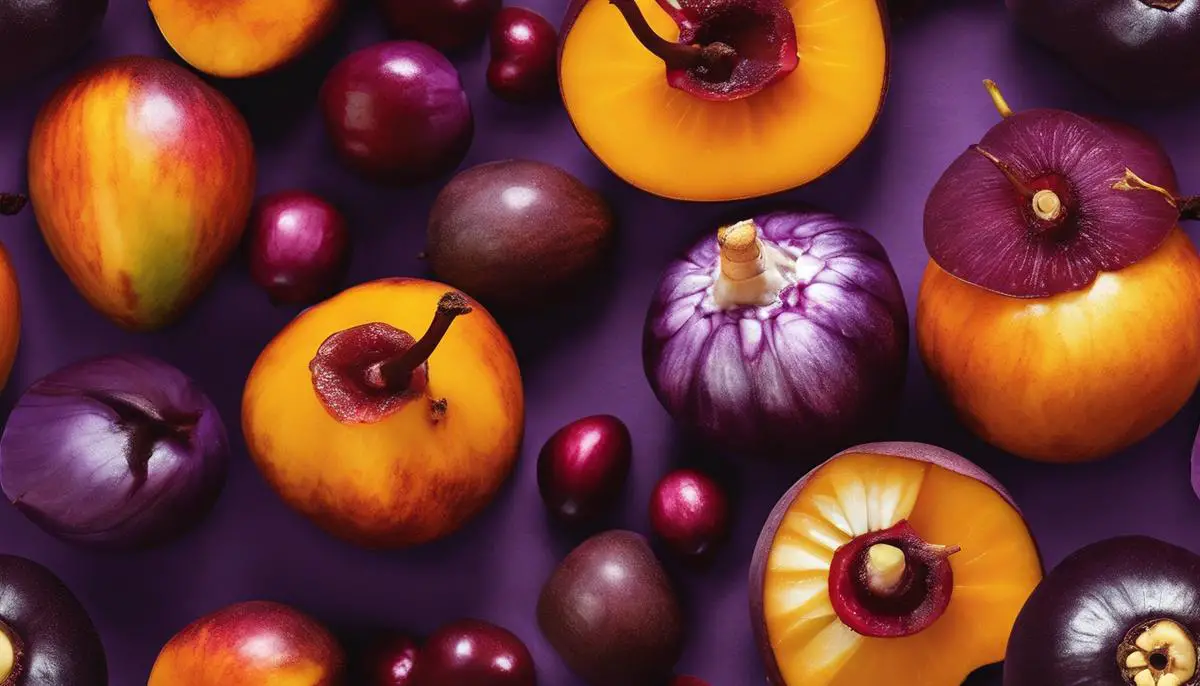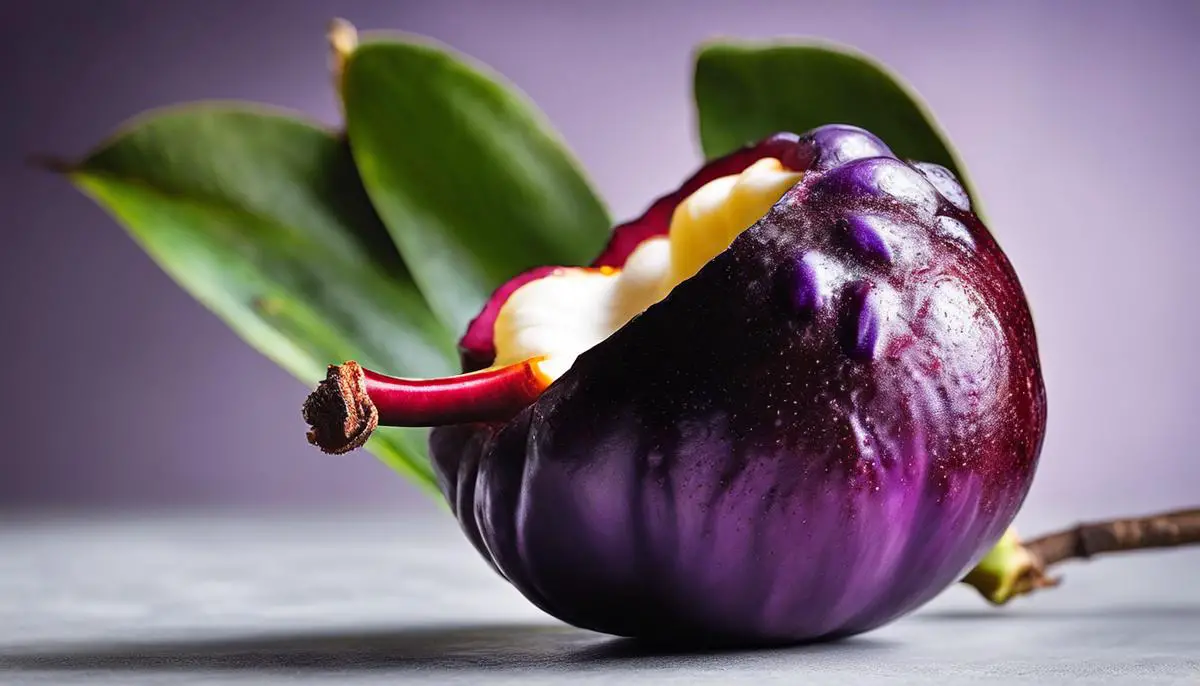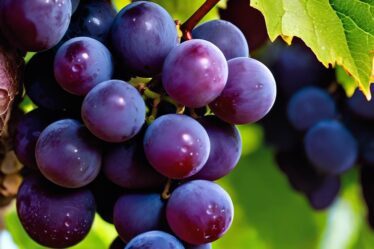
Mangosteen Magic: Experience the Unique Taste of this Exotic Fruit
In the enchanting realms of nature’s bounty, nestled amidst the lush greenery of Southeast Asia’s tropical rainforests, lies a gem of a fruit whose fame has transcended continents – the Mangosteen. Esteemed for its succulent taste and myriad benefits, it encapsulates an exotic symphony of sweetness and nutritional richness. Our journey into its captivating world will traverse through corridors of history, culinary expanse, nutritional prowess, global market dynamics, and practical aspects of sourcing and storing this wonder fruit. Prepare to embark on this exciting expedition and unlock the intriguing secrets of Mangosteen!
Origin and History of Mangosteens
An Exotic Delight Revealed!
Their dark, glossy exterior hides a burst of bright flavor that lingers delicately on your tongue. It’s no exaggeration when the foodie world fondly refers to mangosteens as the “queen of fruits”. But have you ever stopped and wondered about the riveting backstory of mangosteens?
Native to Southeast Asia, mangosteens have quite an illustrious history dating back centuries. Primarily cultivated in Thailand, Malaysia, and the Philippines, these bespangled gems have remained adorably petite, easy-to-hold, with firms skins that yield to reveal succulent, snow-white flesh.
Dazzling from the first look, you would believe that mangosteens have been relished worldwide from time immemorial. Strangely enough, though, the journey of mangosteens is one elusively shielded in intrigue and travel. They’ve only recently started making consistent appearances in western markets and their tantalizingly sweet-tart flavor has left food enthusiasts wanting more.
Why this late entry, you might ask? Well, it’s due to an intriguing combination of cultivation difficulty and stringent import restrictions. While it’s like to portray an air of hardy resilience, they are quite the prima donnas. Growing them means understanding their whims and fancies. They thrive in ultra-tropical environments, cannot tolerate temperatures below 40ᵒF, and also require a lot of water. Adding to this, they can be quite coy and may take up to 10 years to bear fruit!
The real adventure of mangosteen begins with their notorious transportation issues. In the 19th century, attempts to introduce mangosteens to the American soil were mostly unsuccessful. The seedlings, sensitive to a fault, would fail to adapt to the new climates. This led to a disheartening period where the West knew about the mangosteen but was unable to cherish it.
In the 20th century, mangosteens continued to remain elusive due to the American agricultural policies, which restricted entry to fruits that could potentially threaten domestic crops. The major concern was the potential spread of the Asian fruit fly, found in Southeast Asia, which could damage America’s fruit industry. Therefore, until 2007, it remained a forbidden fruit barring few exceptions.
However, thanks to irradiation technology, a tipping point was reached. This technology made it possible to kill fruit flies and other pests, leading to it’s finally making their grand entrance into the American markets.
What does this mean for the daring food explorer? It means a chance to embark on a unique taste odyssey. The flavor profile that packs a medley of strawberry, peach, and vanilla ice cream notes commands a connoisseur’s exploration.
After being tantalized for years and the allure of tasting this sweet, tart, creamy fruit, the moment of slicing open a fresh mangosteen is nothing short of magical. Satisfying beyond belief, you find that the myriad of flavors offered by this little gem was worth every story, every wait.
Remember that the joys of the culinary world are not tied to what is readily available but in the discovery of new sensations and flavors. Such is the charm of mangosteens—a product of a confluence of history, regulations, and nature’s deal of cards—that fuels the spirits of culinary adventurers around the world.
Relishing a mangosteen isn’t just experiencing a new flavor. It’s about holding a piece of history and indulging in a passion for exploration and discovery. It’s about embracing the journey equally as the destination. As they say, food indeed is what connects us. Isn’t it time you discovered your connection with the queen of fruits?

Culinary Uses of Mangosteen
A Culinary Adventure
While mangoes, pineapples, and coconuts have managed to make resounding names for themselves within the culinary world, one tropical fruit remains largely unexplored, yet highly desirable by chefs and gourmands alike; the Mangosteen. This Southeast Asian gem has been gradually creating waves in various cuisines globally, becoming a coveted ingredient for those in the know in search of that intriguingly new taste sensation.
Beyond the murky tales of origins and uneasy cultivation, what truly elevates the mangosteen in the eyes of the gastro explorer is the intoxicating essence trapped within its hard, purple rind. To taste this fruit is to embark on an adventure into the indulgent nuances of sweet, sour, and faintly bitter undertones, creating sensorial splashes that can elevate any dish they are incorporated into.
In the world of beverage production, mangosteens serve as the star ingredient in a plethora of drinks, including cocktails, smoothies, and juices. The lusciously tart sweetness of a blended mangosteen drink delivers an exuberant punch of flavor that infuses a tropical atmosphere to any occasion. Moreover, the low-calorie profile of this fruit stands as a bonus for health enthusiasts, making this tropical drink as nutritious as it is refreshing.
In the culinary landscape, the Mangosteen has significantly influenced the development of several Asian and fusion cuisine menus. Known to provide a much-desired sweet and tangy balance, this captivating fruit makes an appearance in numerous savory sauces, desserts, and snacks. Its unique flavor profile has the ability to tantalize the taste buds, keeping them yearning for the next bite.
From a nutritional perspective, the Mangosteen is indeed a testament to the idiom that good things come in small packages. Besides being low in calories, this petite powerhouse is loaded with essential nutrients, vitamins and loaded with powerful antioxidants, making it as good for the body as it is pleasant to the palate. This perfect combination makes it an ideal candidate for health-focused culinary endeavors.
There’s an undeniable joy in culinary experimentation. A search, often ongoing, to introduce that unexpected element which will command attention and provide an unforgettable experience. The Mangosteen is one such treasure that adds novelty to the table. Despite its unassuming appearance, this tropical delight can transform an ordinary dish into something extraordinary, an unforgettable gourmet’s delight.
Therein lies the essence of why the Mangosteen is becoming a sought-after ingredient in the culinary world. It’s not just a fruit but a symbol, standing for the thrill of discovery and passion for culinary innovation. To embrace this fruit is to welcome an exciting whirlwind of flavors, to hold in your hand a truly global ingredient and most importantly, to celebrate the spirit of culinary adventure. Let’s raise a toast, or perhaps, a treat to Mangosteen, a fruit that certainly knows how to bring the “extra” to the ordinary!

Nutritional Facts and Health Benefits of Mangosteens
Underneath the deep regal hue of the mangosteen lies a host of nutritional riches and health benefits that make it an ingredient coveted by those who love to cook, eat, and explore. Hiding beneath the tough, tannin-rich pericarp, or outer skin is a sweet and tangy succulent flesh. Not only is each bite a delightful of flavors, but also an opportunity to boost health and wellness.
Without a doubt, the mangosteen reigns supreme as the queen of fruits on the dual throne of flavor and nutrition. Let’s delve into the fount of nutritional treasures this fruit holds and how it benefits our health.
The fiber-packed pulp of the mangosteen is a marvel. Fiber is our trusty diet ally, promoting a healthy digestive system. It’s like a thorough cleaning service for our intestines, sweeping out toxins and helping to prevent constipation. Furthermore, dietary fiber helps maintain a healthy weight and lowers the risk of diabetes, heart disease, and some types of cancer.
Mangosteen is a celebrity when it comes to its vitamin C content. This immune system ninja is a potent antioxidant, warding off viruses and bacteria. Vitamin C is also vital in the formation of collagen, a protein that helps keep skin, hair, and nails in their Hollywood best.
Teeming with essential minerals like magnesium, manganese, and potassium, the mangosteen stakes a legitimate claim on being a functional food. For instance, magnesium is a co-factor in many enzyme systems and is involved in protein synthesis. Meanwhile, potassium helps to maintain fluid balance in the body, essential for regulating blood pressure and heart function.
As any great culinary experimenter would attest, one of the most intriguing aspects of the mangosteen is the presence of Xanthones – a unique class of biologically active compounds possessing numerous bioactive capabilities. These include anti-inflammatory, anti-cancer, and antioxidant properties. The fruit is believed to contain more Xanthones than any other food source, packing a potential preventative punch against a range of diseases.
The benefits don’t end there! The purple rind of the mangosteen, while bitter, is incredibly beneficial. Rich in tannins, these antioxidants have antimicrobial properties and could aid in alleviating diarrhea, reducing cholesterol, and treating certain skin conditions.
With mangosteen infused into meals, beverages, desserts, or simply enjoyed fresh, one is not only embarking on a gustatory adventure but also an odyssey of wellness. Here’s a wonderful testament to the merging world of gastronomy and health, a gift of nature that strengthens the joy of eating with nourishment and vitality.
Let’s salute the mangosteen’s wealth of nutritional treasures; a royal ingredient in the kitchen, potent with flavor, and abundant with health privileges. Exotic fruits have never tasted so good or been so rewarding!

Global Market and Commercialization of Mangosteens
Transforming from a rare and exotic fruit to a global sensation, the mangosteen has definitely come a long way. This tropical delight has piqued the interest of food enthusiasts around the globe, leading to its rising popularity, but more than that, these fruits carries with it the spirit of culinary exploration borne out of passion and curiosity.
When we talk about the mangosteen, we cannot ignore its powerful health benefits that have been recognized in traditional medicine for years. However, modern researchers have also turned their attention to this powerhouse of nutrients, primarily its potent source of antioxidants. These antioxidants help neutralize harmful free radicals in the body, potentially reducing the risk of several chronic diseases. Indeed, the appeal of the mangosteen extends far beyond its sweet flavor profile.
Another remarkable aspect of the mangosteen involves the culinary arts. The flavor of this fruit is truly unique – sweet yet tangy with a hint of bitterness in the end, presenting an exciting challenge for any culinary enthusiast. Moreover, its versatility has made it a sought-after ingredient in both savory dishes and desserts. The slight bitterness of the rind, which at first may seem like a hindrance, has actually broadened the horizons even more, proving that when it comes to food, every part counts!
Furthermore, the cachet of mangosteens has seen a noticeable rise in the beverage industry. The distinct flavors found in this fruits have made them a darling for mixologists and bartenders around the globe. From tropical mixers to wellness juices – the possibilities are endless. It’s the quest to experiment and innovate that puts mangosteen at center stage among the foodie crowd.
The global commodification of mangosteens could also be attributed to their value in promoting well-being. The modern consumer is not just about eating well but also eating smart, looking for foods that are both delightful and beneficial. The mangosteen with its phytonutrients and other essential minerals seems to satisfy this demand flawlessly.
Finally, the mangosteen represents more than just a fruit – it’s a symbol of the culinary world’s endless possibilities, the discovery of new flavors, and the enriching intersection of culture, history, and food. You might even go as far as saying that each bite of this delectable fruit is a bite into the very spirit of gastronomic adventure.
So, has the mangosteen become a global commodity? Absolutely. This tropical marvel has managed to bridge the gap between the exotic and the familiar, between pleasure and health, and between tradition and innovation. In essence, the story of the mangosteen is a feast for not just the taste buds, but the soul too. Because after all, isn’t that what food is all about?

Sourcing and Storing Mangosteens
Navigating the world of fruits can often take us down the road less travelled, beyond everyday grocery aisles, and into exotic terrains where treasures like the mangosteen await discovery. Though its origination and cultivation aspects may coax us into spinning enchanting tales or digging deep into historical explorations, our focus now serendipitously shifts towards the more practical aspect. A culinary adventurer is always on the lookout for answers to critical questions – where to source these exotic gems and how to keep them fresh.
The elusive mangosteen, being native to Southeast Asian countries, can still be sourced in parts of America with a bit of diligent searching. Asian grocery stores often feature a variety of imported tropical fruits, and mangosteens have started to make a regular appearance. Also, farmers’ markets in areas with a significant Asian populace can be potential gold mines. Online shopping portals like Amazon and specialty food sites also offer canned or frozen mangosteens, maintaining accessibility all year round.
But nothing beats tasting a fresh mangosteen, and during the summer season, certain gourmet food stores or even regular supermarkets might just surprise you with a fresh stock. Large cities, in particular, are seeing an increased demand for these exotic foods, causing a steady infiltration into mainstream markets.
Once these rare beauties have been procured, maintaining their optimal freshness becomes the next gastronomic challenge. With a bit of knowledge and a few tips, you can easily enjoy a fresh mangosteen at its peak.
Never store mangosteens in the refrigerator. This tropical delight fares well at normal room temperatures. It is key to retain the mangosteen at ambient temps, avoiding both too cold and too hot environments. The fruit’s outer rind is tough, acting as a natural preservative, so mangosteens can be kept at room temperature for about a week.
If you need to store mangosteens for a longer span, near about two weeks, keep them in a cool place away from direct sunlight. A mesh or paper bag can also help keep them fresh as it allows circulation of air. In case the fruit is a little underripe, it can be kept in a paper bag with a ripe apple or banana to speed up the ripening process.
Remember, the freshness of mangosteen can be judged by its outer appearance. The skin should be a vibrant magenta without any visible blemishes or spots, the ‘flower’ at the top should be intact, and it should feel firm when lightly squeezed.
Finding mangosteens and maintaining their freshness might seem like a wild fruit chase. But the rewards are worth the hunt. Slipping past the leathery rind to reveal the soft, snow-colored flesh beneath, a mangosteen delivers a burst of sweet juice with a slight tang, bringing a welcome novelty to the palate.
Whether using them to splash up a tropical cocktail, infuse into a savory sauce, or simply savoring the raw fruit, this pursuit of the mangosteen perfectly highlights the sheer joy and boundless creativity that cooking endeavors bring. One can’t help but soak up the thrill of this culinary escape, all while stepping up a game or two in their kitchen adventures.
It’s only through such uncharted culinary journeys that one gets to taste life at its freshest. And mangosteens, with their enticing fusion of flavor and nutrients, offer an experience that refreshingly satiates both the body and the spirit. Here’s to celebrating the love of food, a universal thread that binds us all – the same love that leads us to such diverse and delicious discoveries as the mangosteen!

As we unravel the last threads of the Mangosteen story, it is evident that this fascinating fruit is much more than a tasty treat. Nurtured in the embrace of nature, Mangosteen has journeyed from the shadowy undergrowth of Southeast Asia to the global spotlight, winning hearts with not only its unique flavor profile but also its impressive nutrient content. It has spawned industries, influenced cuisines, and continues to contribute to our health and well-being. From its juicy pulp to the vibrant rind, every inch of the Mangosteen fruit exudes a mesmerizing tale. May this exploration enable you to fully appreciate, harness, and revel in the sensational world of Mangosteens!



